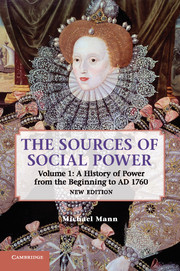Book contents
- Frontmatter
- Contents
- Preface to the new edition
- Preface
- 1 Societies as organized power networks
- 2 The end of general social evolution: how prehistoric peoples evaded power
- 3 The emergence of stratification, states, and multi-power-actor civilization in Mesopotamia
- 4 A comparative analysis of the emergence of stratification, states, and multi-power-actor civilizations
- 5 The first empires of domination: the dialectics of compulsory cooperation
- 6 “Indo-Europeans” and iron: expanding, diversified power networks
- 7 Phoenicians and Greeks: decentralized multi-power-actor civilizations
- 8 Revitalized empires of domination: Assyria and Persia
- 9 The Roman territorial empire
- 10 Ideology transcendent: the Christian ecumene
- 11 A comparative excursus into the world religions: Confucianism, Islam, and (especially) Hindu caste
- 12 The European dynamic: I. The intensive phase, a.d. 800–1155
- 13 The European dynamic: II. The rise of coordinating states, 1155–1477
- 14 The European dynamic: III. International capitalism and organic national states, 1477–1760
- 15 European conclusions: explaining European dynamism – capitalism, Christendom, and states
- 16 Patterns of world-historical development in agrarian societies
- Index
- References
5 - The first empires of domination: the dialectics of compulsory cooperation
Published online by Cambridge University Press: 05 July 2013
- Frontmatter
- Contents
- Preface to the new edition
- Preface
- 1 Societies as organized power networks
- 2 The end of general social evolution: how prehistoric peoples evaded power
- 3 The emergence of stratification, states, and multi-power-actor civilization in Mesopotamia
- 4 A comparative analysis of the emergence of stratification, states, and multi-power-actor civilizations
- 5 The first empires of domination: the dialectics of compulsory cooperation
- 6 “Indo-Europeans” and iron: expanding, diversified power networks
- 7 Phoenicians and Greeks: decentralized multi-power-actor civilizations
- 8 Revitalized empires of domination: Assyria and Persia
- 9 The Roman territorial empire
- 10 Ideology transcendent: the Christian ecumene
- 11 A comparative excursus into the world religions: Confucianism, Islam, and (especially) Hindu caste
- 12 The European dynamic: I. The intensive phase, a.d. 800–1155
- 13 The European dynamic: II. The rise of coordinating states, 1155–1477
- 14 The European dynamic: III. International capitalism and organic national states, 1477–1760
- 15 European conclusions: explaining European dynamism – capitalism, Christendom, and states
- 16 Patterns of world-historical development in agrarian societies
- Index
- References
Summary
The preceding chapter contained familiar themes, some drawn from local evolutionism, some from comparative sociology. Civilization, social stratification, and states originated in the local circumstances of about six broadly similar societies scattered across the globe. Alluvial and irrigation agriculture situated amid overlapping regional networks of social interaction intensified a two-level social cage. In turn, this led to exponential growth in human collective power.
Some of these broad themes continue in this chapter, which describes a further phase of the early history of civilization. Now the social cage became more pronounced, more singular, and much more extensive as a result of another regional interaction process. This time the initial stimulus was less from economic than from military organization. And the resulting geopolitical pattern also shifted. What had been hitherto semiperipheral areas became, in a sense, the new core of civilization. “Marcher lords” were the pioneers of hegemonic empire.
As a similar broad pattern can be seen emerging across most of the cases, this again suggests a general developmental tendency. But now there are even more obvious differences between them. My response is to stick even more closely to the development of the Near Eastern civilization, the best documented and most historically significant case. As we are now firmly in the realm of history, documentation improves and I will be able to look more systematically at the infrastructure of power and at its four distinct organizational means (as promised in Chapter 1).
- Type
- Chapter
- Information
- The Sources of Social Power , pp. 130 - 178Publisher: Cambridge University PressPrint publication year: 2012



